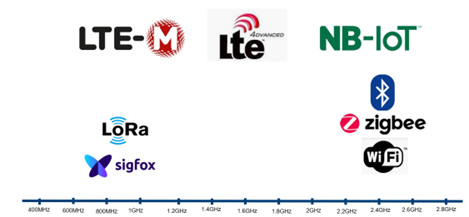What is Wireless Coexistence?
Wireless coexistence is the capability of multiple wireless devices and services in the same geographical area to access the same RF spectrum band simultaneously without causing harmful interference to one another. In other words, can they all operate successfully and safely without any risk to an operator or a patient and maintain adequate wireless performance?
An example of wireless coexistence of various technologies (Zigbee, WIFi, BLE) operating in the same frequency band is described in the image below:

What is the difference with the traditional EMC testing?
Traditional electromagnetic compatibility or interference tests typically address the impact of one-way interference from one party to a victim party through unintentional emitters or receivers. Wireless coexistence testing addresses the mutual interactions and performance of all the involved intentional emitters and receivers
Wireless coexistence of medical devices
Crowded radio frequency (RF) signal environments — such as hospitals with many patients, medical staff, and their wireless devices — compete for the available RF spectrum.
Medical wireless devices, like IOT devices and other wirelessly connected devices, generally operate within the common frequency spectrum reserved for international use and in the industrial-scientific-medical (ISM) frequency bands (such as 2.4 to 2.5 GHz and 5.725 to 5.875 GHz).
For patient safety reasons, the FDA has required an assessment of wireless coexistence for medical devices.
What are applicable standards for wireless coexistence for medical devices?
The Food and Drug Administration (FDA) issued guidelines to address wireless coexistence for medical devices and recognized the following ones:
ANSI C63.27:2021: American National Standards Institute – Standard for Evaluation of Wireless Coexistence (2021)
The standard specifies methods for assessing the radio frequency (RF) wireless coexistence of medical devices that incorporate RF communications.
Below are the tiers for coexistence per ANSI 63.27. The tier is determined based on the consequences of Functional Wireless Performance (FWP) Failure and is determined through a risk analysis (see AAMI TIR69 – “Risk management of radio-frequency wireless coexistence for medical devices and systems”).

AAMI TIR69:2017/(R)2020: Technical Information Report – Risk management of radio-frequency wireless coexistence for medical devices and systems.
What can SIQ offer you?
- We can support you with the preparation for the wireless coexistence testing (test plan).
- We can support you with Tier 3 and Tier 2 testing according to ANSI C63.27:2021.
- We can support you with wireless coexistence testing with the use of an advanced vector signal generator for simulating different wireless protocols (LTE, WIFI, BLE, etc.).